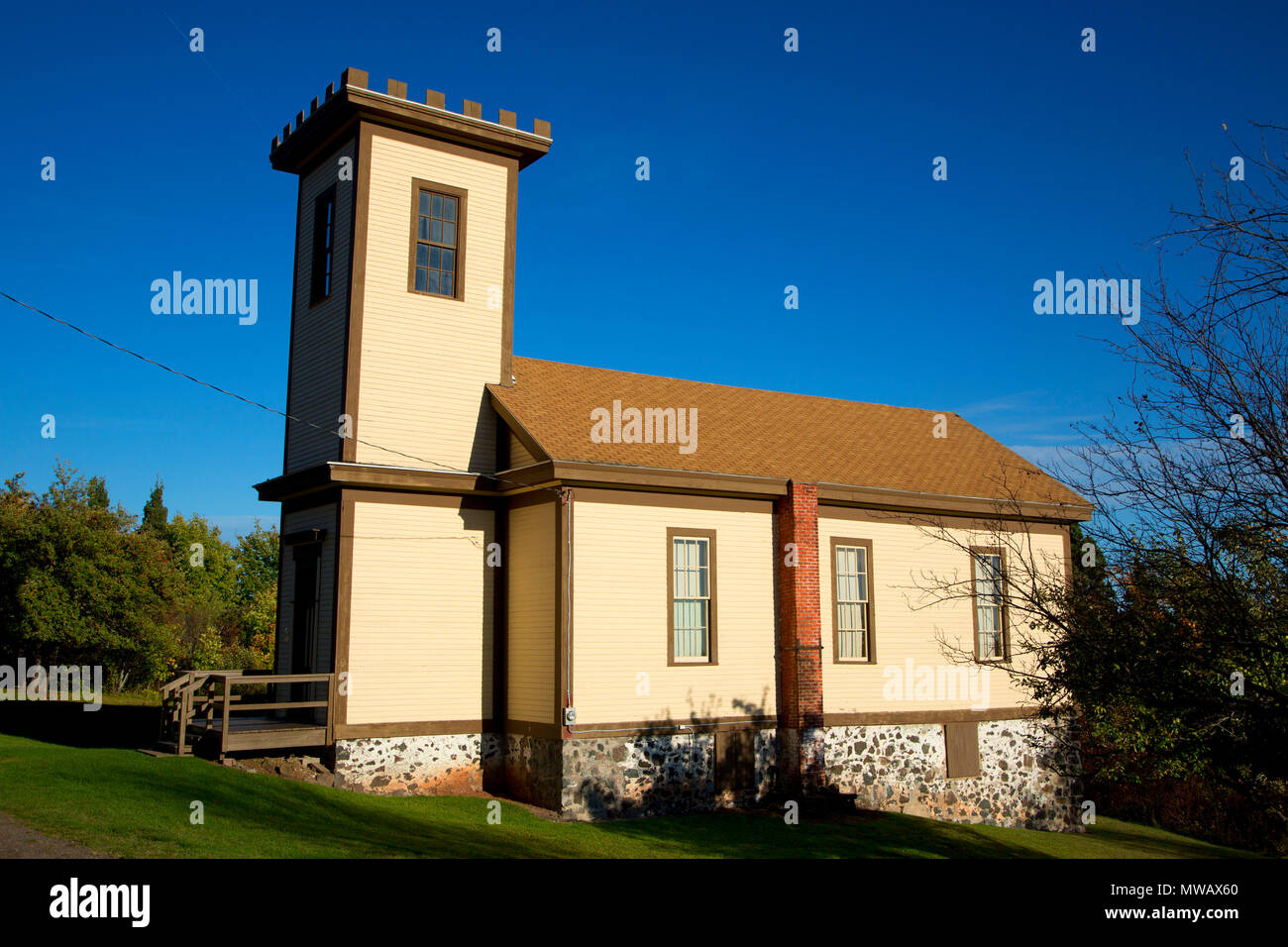
Echoes in the Copper Country: The Enduring Legacy of Michigan’s Central Mine
In the rugged, pine-scented expanse of Michigan’s Upper Peninsula, where Lake Superior’s vastness stretches to the horizon and ancient rock formations bear witness to geological epochs, lies a landscape etched with stories of human endeavor. Here, on the Keweenaw Peninsula, a finger of land renowned for its geological anomaly, sits the Central Mine – a name that, for many, conjures images of a bygone era, a testament to the brutal beauty and relentless pursuit of mineral wealth that defined America’s Copper Country. Today, the site is a tranquil, windswept historical park, but beneath its serene surface lie the echoes of a boom-and-bust cycle, the triumphs and tragedies of thousands who sought their fortune in the deep earth.
The story of Central Mine is inextricably linked to the broader narrative of the Keweenaw, a region unlike any other. While California was consumed by its gold rush, Michigan’s Upper Peninsula experienced its own "copper fever." Unlike the disseminated copper ore found elsewhere, the Keweenaw boasted rare deposits of native copper – pure, elemental copper found in massive chunks and veins, often requiring little processing beyond extraction. This geological marvel, documented by Douglass Houghton in the 1840s, ignited a frenzy of exploration and investment, transforming a remote wilderness into a bustling industrial frontier.
The Birth of a Copper Giant (Relatively Speaking)

The Central Mining Company was officially organized in 1854, emerging from the initial wave of speculative ventures that followed Houghton’s surveys. Its location, nestled in what would become known as the "Central Mine District" (a geological designation, not necessarily a geographical one), proved fortuitous. Early exploratory shafts quickly revealed rich veins of native copper, cementing Central Mine’s reputation as one of the Keweenaw’s most promising prospects.
What distinguished Central Mine early on was its consistent profitability. While many mines struggled and failed in the harsh environment and challenging geology, Central quickly hit pay dirt. From its inception until its closure in 1898, the mine consistently produced high-grade copper, ultimately extracting an astonishing 51,036,606 pounds of refined copper. This made it one of the most successful independent operations of its time, often overshadowed only by the colossal Quincy Mine and the later behemoth, Calumet & Hecla.
The extraction process was arduous and dangerous. Miners, many of them immigrants from Cornwall, Ireland, and later Finland, descended hundreds, then thousands of feet into the earth. The deepest shaft at Central Mine eventually reached over 2,800 feet, a staggering depth for the technology of the era. They wielded hammers and chisels, then later primitive drills powered by steam and compressed air, to chip away at the tough amygdaloid rock. Blasting powder shattered the rock face, and the precious copper, sometimes found in enormous masses weighing tons, had to be carefully cut, hoisted, and transported to the surface. One can imagine the deafening cacophony underground, the constant threat of rockfalls, flooding, and the ever-present danger of explosions.
Life in a Company Town: A Self-Contained World
Like many mining operations of the era, Central Mine was not just an industrial site; it was a self-contained community. The company owned virtually everything: the land, the mines, the houses, the general store, the school, the church, and even the hospital. This paternalistic system, while providing essential services in a remote region, also exerted immense control over the lives of its employees.
The mine’s population swelled to over 1,200 residents at its peak in the 1870s. The town, built around the mine shafts, consisted of rows of modest homes, a bustling company store where goods were often purchased on credit against future wages, a schoolhouse for the children, and a Methodist church that served as the spiritual and social heart of the community. Life was hard, dictated by the mine’s whistle and the relentless pursuit of copper. A miner’s day began before dawn and often ended after dusk, with little leisure time.
The Cornish, known for their centuries of mining expertise from their homeland, formed the backbone of the workforce. Their unique culture, including their pasties (meat and potato pies, perfect for a miner’s lunch) and their strong community bonds, left an indelible mark on the Keweenaw. They were later joined by Irish immigrants fleeing famine and, towards the end of the century, by Finnish families seeking new opportunities. This multicultural tapestry, forged in the crucible of hard labor, created a vibrant but often tense social environment. Despite the hardships, a strong sense of community and solidarity often prevailed, born out of shared experience and mutual reliance in a challenging environment.
The Slow Decline and Inevitable Closure

The prosperity of Central Mine, like that of many Keweenaw operations, was not destined to last forever. Several factors conspired to bring about its eventual decline and closure in 1898. Firstly, the very nature of native copper mining meant that as the richest veins were depleted, miners had to go deeper and deeper, increasing the cost and difficulty of extraction. Pumping water from ever-greater depths became a constant battle, and the rock itself became harder to break.
Secondly, the price of copper, subject to global markets and economic fluctuations, often dipped, making less productive mines unprofitable. Central Mine, while successful, was never as massive as its competitors like Quincy or Calumet & Hecla, which benefited from economies of scale and more extensive ore bodies. These larger companies could weather downturns more effectively.
Finally, the technology of copper processing was evolving. While Central excelled at extracting native copper, other mines began to perfect methods of concentrating lower-grade copper ore. This meant that mines with vast, lower-grade deposits could become profitable, shifting the economic landscape away from the pure native copper operations.
When the final decision to close Central Mine was made, it sent ripples through the community. Families who had lived there for generations were forced to pack up their meager belongings and seek work elsewhere, often migrating to other mines in the region, to Detroit’s burgeoning auto industry, or even further afield. The once-bustling town slowly emptied, its houses abandoned, its mine shafts silenced, and its once-vibrant streets reclaimed by the encroaching wilderness.
A Legacy Preserved: Central Mine Today
For decades, Central Mine became a ghost town, a poignant reminder of a forgotten era. The elements began their work, slowly eroding the wooden structures and rusting the iron machinery. However, the story of Central Mine was too important to be lost entirely. In the latter half of the 20th century, efforts began to preserve what remained of this significant piece of American industrial history.
Today, Central Mine is a partner site of the Keweenaw National Historical Park, meticulously maintained and interpreted by the Keweenaw County Historical Society. Visitors can walk among the ruins, see the towering rock house, peer into the depths of the capped mine shafts, and explore some of the preserved miners’ homes and the historic Methodist church. The church, remarkably, still holds services during the summer months, a living link to the community that once thrived here.
The visitor center, housed in a restored mine building, offers exhibits that bring the past to life, detailing the geology, the technology, and the human stories of Central Mine. One of the most striking features is the sheer scale of the equipment – the massive rock house foundations, the immense steam engine beds, and the sheer drops into the mine shafts, all of which underscore the monumental effort involved in extracting copper from the earth.
Walking the grounds, one can almost hear the faint echoes of the past: the clang of hammers, the rumble of rock cars, the laughter of children, and the somber tolling of the church bell. Central Mine stands as a powerful testament to the ingenuity, resilience, and sheer grit of the men and women who carved out a life in the demanding Copper Country. It reminds us of the boom-and-bust cycles inherent in resource extraction, the profound impact of industry on both landscape and society, and the enduring human spirit that seeks opportunity even in the harshest of environments.
Central Mine is more than just a collection of historical buildings and abandoned shafts; it is a vital chapter in the story of Michigan and the American industrial age. It invites contemplation on the cost of progress, the sacrifices made, and the legacy left behind – a legacy that continues to resonate in the silent, windswept beauty of the Keweenaw Peninsula, where the echoes of copper fever still whisper through the trees.


